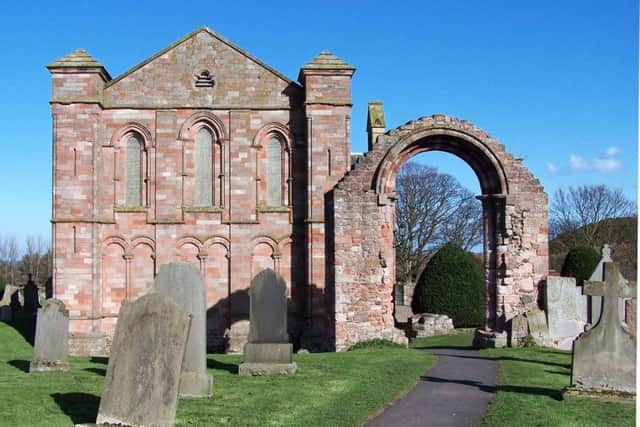Lost home of 7th Century Princess ‘found in the Borders’
and live on Freeview channel 276
Princess Æbbe founded a monastery near Coldingham around 1,400 years ago with the religious centre destroyed by Vikings raiders in the 9th Century.
Several unsuccessful attempts have been made to find the traces of the religious centre in the past but a breakthrough may have been made by archaeologists working with DigVentures.


Advertisement
Hide AdAdvertisement
Hide AdTraces of a large, narrow ditch - believed to be the boundary wall of the monastery - have been unearthed.
A pile of butchered animal bones were also found nearby with radiocarbon dating confirming they were from between AD660 and AD860 - around the time of the monastery era and the influence of Princess Æbbe.
Manda Forster from DigVentures told the BBC: “The section of boundary ditch we found links up with two other ditch sections, and together they seem to encircle Coldingham Priory, meaning that the heart of Æbbe’s monastery is somewhere underneath it.”
She added: “Originally built around AD640 it is said to have burned down shortly after her death, but was then rebuilt and thrived until it was destroyed once again by Viking raiders 200 years later.”
Advertisement
Hide AdAdvertisement
Hide AdArchaeologists earlier believed that the monastery was built closer to the coast.
Ms Forster added: “It is brilliant to finally be able to announce that we’ve found Æbbe’s monastery, and to confirm that part of it is probably underneath Coldingham Priory.
“Æbbe is an extraordinary figure - an example of a powerful Anglo Saxon woman who played a big part in establishing Christianity in the region during the 7th Century.
“Now that we’ve got evidence to pinpoint exactly where her monastery was, we can help bring her story back to life.”
Advertisement
Hide AdAdvertisement
Hide AdÆbbe, who was born in AD615, was the daughter of Æðelfrith, a pagan warlord and King of Northumbria.
He ruled from his ancestral fortress at Bamburgh, on the coast opposite the tiny tidal island of Lindisfarne.
After 24 years in power, Æðelfrith was slain by his brother-in-law, Edwin, a Deiran prince whose lands lay to the south, in what is now Yorkshire east of the Pennines, a statement from DigVentures said.
Acha, Æbbe’s mother and Edwin’s sister, fled north to Scotland to seek the sanctuary of distant relatives at the court of Eochaid Buide – or Eochaid Yellow-hair - in the kingdom of Dál Riata.
Advertisement
Hide AdAdvertisement
Hide AdIt was here that Æbbe came under the influence of Christianity with the princess’ brothers fighting in dynastic wars and then later educated on Iona.
The family returned to Northumbria, with Æbbe’s brother leading a band of his father’s warriors and a party of Dál Riatan youngbloods.
A band of Ionan monks may also have joined the group with the party taking control of Bamburgh Castle and founding a monastery on Lindisfarne.
A spokesman for DigVentures said: “This was the first step in the Christianisation of his people, who were still largely a pagan population.
Advertisement
Hide AdAdvertisement
Hide Ad“With a safe passage home, Æbbe returned to Northumbria,” the statement added.
According to some accounts, Æbbe had by this point already become a nun to avoid the advances of an unwanted suitor, Prince Aidan.
She stubbornly defied her family’s wishes and fled up to Coldingham, about 25 miles past Lindisfarne.
She soon established a monastery at Coldingham. Unlike Lindisfarne, Aebbe’s monastery was double monastery, home to both monks and nuns, and was recorded by the name of ‘Urbs Coludi’ by the medieval historian, Bede.
Advertisement
Hide AdAdvertisement
Hide AdIt later became known as Colodaesburg in Anglo-Saxon, and then Coldingham.
A spokesman for DigVentures added: “We don’t know the full extent of the power Coldingham had in the surrounding area, but with a royal founder and close ties to Lindisfarne, it’s likely that Coldingham was rather more influential than Bede let on in his writings.
“She soon became instrumental in the spread of Christianity to the still largely pagan population on the Northumbrian coast.”
Soon after Æbbe’s death in AD 863, the monastery burnt to the ground.
Advertisement
Hide AdAdvertisement
Hide AdLike Lindisfarne, and many other monastic sites on the north east coast, Coldingham was an easy target for Viking raiders.
Some accounts suggest that the community, then led by Aebbe the Younger, was devastated less than 200 years later, in AD 870.
